Canadians are justifiably proud to live in a country that believes in equality and in the value of a free and accessible health care system. Although this system is strained for capacity, we should still be proud of our goals and what we have achieved. Despite this, there are clearly some issues when it comes to the limits of what can be provided in public health care.
One of the first questions when trying to define these limits is the question of what actually constitutes healthcare? Clearly, a surgery or a visit to a family doctor is healthcare. Just as clearly, a golf round or dinner out at a fine dining restaurant are not healthcare. The questions then come up as we get closer and closer to the edges of “what is healthcare?”: If fine dining isn’t healthcare, what about just dining? What about basic food? A meal in a hospital isn’t fine dining, but it’s considered part of healthcare costs (and paid for by the government), but a meal for someone sick at home is not.
These subtle differences strike at the heart of why it is difficult to develop a system of public home supports that is fair, equitable, and also meets the needs of all Canadians. There is some murky line between changing a bedpan and changing a tire that defines the limit of what Canadian governments are willing to provide.
In BC, one of the compromises we’ve made is that home supports, like long-term care but unlike hospitals, are publicly subsidized but still involve some private payment. Many patients and families are surprised to learn that even support from a public system still costs them a considerable amount.
The formula used in BC to determine the cost of public home support is complex, but for completeness, here it is: “Your daily rate is calculated by multiplying your “remaining annual income” (as defined in the Continuing Care Fees Regulation) by 0.00138889”. The definition of “remaining annual income is even more complex, but is given in the continuing care regulations, and includes the income of both the patient and their spouse, minus reasonable expenses depending on the size of their household.
These fees are determined after an assessment by a case manager and can be waived if the patient is registered for palliative care or in receipt of the Guaranteed Income Supplement. In some cases, though, they can be a major expense for patients on a limited income. The BC Office of the Seniors Advocate estimated in 2023 that for patients paying for daily home supports, the median cost was $15,081 annually. This could amount to a substantial portion of a person’s income, but is still much cheaper than long-term care, either private or publicly subsidized.
The challenge of determining whether something is healthcare leads to strict limits on what public home support workers are allowed to do. Because the supports are publicly delivered even if privately paid, HSWs in the public system can only provide assistance that has been directed by a case manager, usually limited to support with a patient’s (not their spouse’s) activities of daily living. This has led to an array of bewildering stories: frail elderly couples required to split their laundry, food which can be served but not heated up, and medication delivery arranged but then charged to patients who can’t afford it. When we speak to care providers, we hear that they’d like to do more for their patients, but are faced with restrictive policies and high workloads that force them to move on to the next patient.
BC needs care solutions that remove barriers to people remaining at home. For example, removing the administrative middleman that stands between the patient (and their family) and the care provider might be a good way to streamline support. This allows them to decide directly what help they value, and pay for it accordingly, rather than risk paying a high price for services that may or may not be what’s important to them. Indeed, creating these direct connections will be the best way for people to stay happy and thrive in their own home, regardless of whether their needs are considered health care or not.

